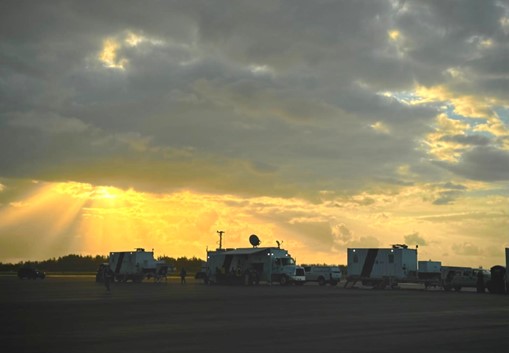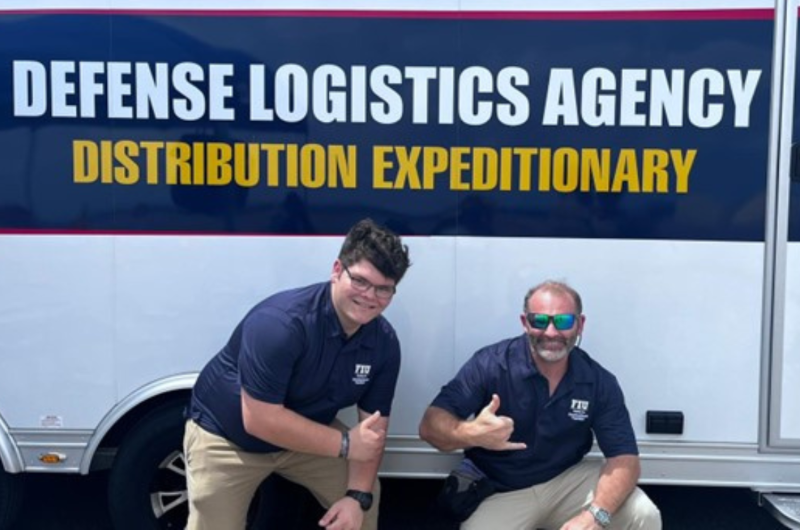Undergraduate students in FIU's Academy for International Disaster Preparedness (AIDP) participated in a simulation hosted by the Federal Emergency Management Agency (FEMA) at Homestead Air Reserve Base in Florida. Held in advance of the current hurricane season, the exercise focused setting up a staging location for emergency vehicles that carry supplies throughout the community and practicing logistical activities to prepare for future hurricane relief responses.
AIDP students Matthew Micalizzi and Edward Crüm were selected to participate in the exercise through a competitive process.
“I am a huge proponent of hands-on, real-world experience—it’s just not something you can get in a classroom, so I signed up,” said student Matthew Micalizzi, whose unique background includes current service as a member of the Coast Guard Auxiliary, the civilian volunteer component of the U.S. Coast Guard.
For Crüm, who is also a combat veteran, emergency management is a familiar field. He’s been stationed in Alaska, Guam and the Middle East and has previously deployed for disaster response and humanitarian relief operations. In Kodiak, Alaska, an area prone to tsunamis, Crüm served as its disaster preparedness officer, maintaining a response trailer equipped with medical supplies and communications equipment. He also pre-positioned supplies in shelters throughout the island to ensure timely, efficient distribution of resources during emergencies.
Crüm enrolled as a student at AIDP to build his knowledge and skills around planning and training. He aspires to eventually land a role within emergency management in Florida and saw participating in the FEMA exercise as a unique way to build his network.
“Meeting professionals in the field and sharing your stories and hearing their stories—that networking is so important, not only for connections in finding employment after graduation, but for the connections after an incident,” he said.
Preparing for a disaster
When disasters hit, emergency responders are met with numerous challenges that can significantly impact the services they provide affected communities. Damage to infrastructure and communication systems, along with insufficient personnel, can cause delays in delivering relief supplies. To mitigate delays, local, state and federal agencies work together to position supplies in strategic locations to ensure communities get what they need once in the aftermath of a disaster. FEMA’s exercise aimed to practice this coordination in real-time, giving the students a unique opportunity to witness these efforts firsthand.
“Preparedness and training are the cornerstones of effective disaster management,” said Robert Jorge, senior director of AIDP. “Equipping future disaster managers like our students with the skills and knowledge they need not only ensures a swift and efficient response to emergencies but also builds a foundation for resilience.”
In preparation for the exercise, Micalizzi and Crüm were invited to listen in on Zoom meetings with FEMA and other participating agencies. “These meetings served as a touchpoint to coordinate planning and resources for the upcoming event,” Micalizzi says.
Practicing disaster preparedness

Trailers and trucks positioned at Homestead Air Reserve Base on the morning of April 8 in preparation for Exercise Eagle Rising
On the morning of the exercise, lined up along the airfield flight line at Homestead Air Reserve Base were semi-trucks with shipping containers—each equipped to carry supplies like food, water, cots and generators. As part of the exercise, participants had to maneuver the semi-trucks on the flight line to simulate the logistical movement of supplies. At the staging areas, the trucks would be received, checked, logged and verified.
In a real-life scenario, challenges and bottlenecks can happen when moving personnel and relief supplies to a location. For instance, inaccurate storm forecasts can lead to limited resources being allocated to areas in need. Insufficient security can put supplies at risk of theft, while poor inter-agency coordination and communication can hinder response efforts.
The exercise simulated challenges like these to help prepare participants for future disaster operations.
“The big thing that I really got out of the exercise was experience and knowledge,” Micalizzi said. “Getting to see these exercises as someone who doesn’t really have that real-world experience yet was something that I’m so grateful for.”
Crüm appreciated being able to connect with participants. “The field of disaster management consists of closely knit professionals and thanks to the opportunity FIU provided for me, I was able to network and interact with FEMA and some of the other key players in this world,” he said.


